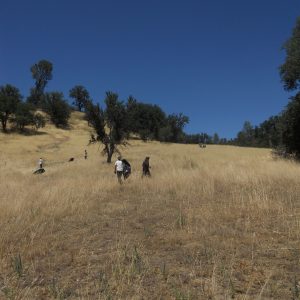
- Assisting our field office’s biological science technician as she leads a hike through Kanaka Valley
In two previous entries (22 June 2011 & 30 Aug 2011), I shared about the “hits and misses of perceived desire,” or, in other words, the ways in which my pre-experience idea of and desire to work in a conservation and land management career matched and didn’t the reality of this career as well as how it fit and didn’t fit with my personality and the way I generally function in day to day life. One statement I made was “Perhaps the all-encompassing factor resulting in a match between my prior perception of land management and the reality of land management based on what I have been learning through first-hand observations and experiences has been the rich variety that accompanies this type of career.” And then I asked “So what kind of variety am I talking about? Sounds like a great topic for another blog entry…”
Here’s the 1st of two entries sharing an area of variety in a conservation/land management career that I’ve discovered and have been enjoying…

- Using ArcGIS to create a map of SOS seed collection locations
Settings. I may be working inside or outside. Typically, indoor work involves the computer, but the tasks performed and the programs used are diverse. I have communicated with email, typed public meeting notes with Microsoft Word, established a record-keeping spreadsheet for our office’s SOS seed collections with Microsoft Excel, created presentations with Microsoft PowerPoint, designed brochures and a poster with Microsoft Publisher, uploaded photos and data from GPS units, and produce maps with ArcGIS; I have also coordinated volunteer work days.

- Pulling yellow star thistle
“In the field” has encompassed a wide range of settings and conditions including but not limited to along trails through chaparral vegetation…and in the thick of it (accessed either by crawling or bushwhacking through the shrubs); oak woodlands, annual grasslands, and pine/cedar forest land; on a hilltop and in a valley…and the slopes in between; in the sun and in the shade; bearing with the heat or with the “cold” (these are definitely relative terms); mostly dry days but also some wet days; a backyard with a small group of concerned neighbors; a school gymnasium with eighty members of the public; and rafting down the South Fork of the American River.

- Setting up for a public meeting (implementing the community-based planning process to develop a management plan for lands recently acquired by the BLM)
People. I have had opportunities to work with a partner or team on a particular projects yet I have also been able to work independently on other assignments. The people I work with have included BLM-employees (preserve manager, biological science technician, botanist, wildlife biologist, directors of fuels management and fire, recreation planner, maintenance specialist), representatives of partnering organizations, volunteers (an undergrad student, members of the Shingle Springs TANF organization), and members of the public (neighbors to BLM land, users of BLM land, elementary students).
More to come in the near future…

Viewing an endangered plant species recently discovered in a new location (biological science technician, botanist, intern)



















